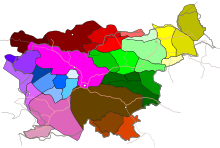Wends dialect
| Prekmurje Slovene | |
|---|---|
| prekmursko narečje, prekmurščina, prekmürščina, prekmörščina, panonska slovenščina | |
| Native to | Slovenia, Hungary and emigrant groups in various countries |
|
Native speakers
|
110,000 (date missing)http://www.anali-pazu.si/sites/default/files/Separat_Josipovic.pdf |
|
Indo-European
|
|
| Language codes | |
| ISO 639-3 | – |
| Glottolog | prek1239 |

Map of Slovenian dialects. Prekmurje Slovene is in dark yellow at the top right.
|
|
Prekmurje Slovene, also known as the Prekmurje dialect, East Slovene, or Wendish (Slovene: prekmurščina, prekmursko narečje, Hungarian: vend nyelv, muravidéki nyelv, Prekmurje dialect: prekmürski jezik, prekmürščina, prekmörščina, prekmörski jezik, panonska slovenščina), is a Slovene dialect belonging to a Pannonian dialect group of Slovene. It is used in private communication, liturgy, and publications by authors from Prekmurje. It is spoken in the Prekmurje region of Slovenia and by the Hungarian Slovenes in Vas County in western Hungary. It is closely related to other Slovene dialects in neighboring Slovene Styria, as well as to Kajkavian with which it retains partial mutual intelligibility and forms a dialect continuum with other South Slavic languages.
The Prekmurje dialect is spoken by approximately 110,000 speakers worldwide. 80,000 in Prekmurje, 20,000 dispered in Slovenia (especially Maribor and Ljubljana) and 10,000 in other countries. In Hungary it is used by the Slovene-speaking minority in Vas County in and around the town of Szentgotthárd. Other speakers of the dialect live in other Hungarian towns, particularly Budapest, Szombathely, Bakony, and Mosonmagyaróvár. The dialect was also spoken in Somogy (especially in the village of Tarany), but it has nearly disappeared in the last two centuries. There are some speakers in Austria, Germany, the United States, and Argentina.
...
Wikipedia
